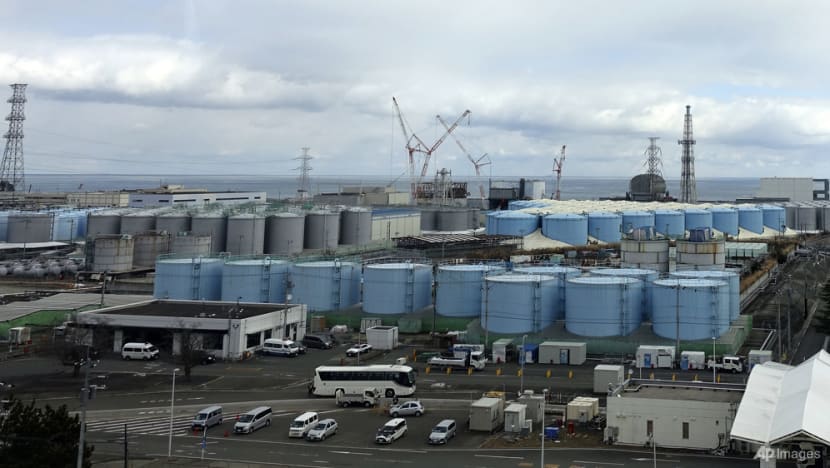Scientists say Fukushima nuclear water released into the ocean is safe, but should we be worried?
Japan will release treated radioactive water - enough to fill 500 Olympic-sized swimming pools - into the ocean over several decades.

About 1,000 huge tanks holding treated but still radioactive wastewater at the Fukushima Daiichi nuclear power plant, operated by Tokyo Electric Power Company Holdings (TEPCO), in Okuma town, northeastern Japan, on Feb 22, 2023. (File photo: AP/Mari Yamaguchi)
Releasing treated radioactive water from the tsunami-wrecked Fukushima nuclear plant into the Pacific will further strain the world’s oceans, which are already absorbing the brunt of climate change and pollution, said experts.
On Tuesday (Jul 4), the United Nations’ nuclear watchdog said a two-year review showed Japan's plans to release treated water into the sea were consistent with global safety standards.
The move would have a “negligible radiological impact to people and the environment”, said the International Atomic Energy Agency (IAEA).
However, Dr Robert Richmond, director of the Kewalo Marine Laboratory at the University of Hawaii, said today's ocean is already compromised.
“We see ocean pollution, overfishing, and climate change impacts. So we're not dealing with a clean canvas here,” he told CNA938 on Wednesday.
“We have an ocean that's already stressed and the people who depend on the ocean are already feeling the effects. And now we're adding a new layer of stressors.”
Experts are divided on whether the release of treated water from the Fukushima plant into the sea would be safe.
“The reason is that there are so many data gaps remaining. The idea that you're meeting accepted standards, as a biologist, doesn't convince me at all,” said Dr Richmond.
“Science is moving ahead on a daily basis, and yet many of the standards that have been established are years to decades old.”
Several of the Fukushima Daiichi plant's reactors went into meltdown after cooling systems were overwhelmed by a massive tsunami in 2011.
WASTEWATER FILTERED TO REMOVE MOST RADIOACTIVE ELEMENTS
Japan's government maintains that it has treated the water - enough to fill 500 Olympic-sized swimming pools - that was used to cool the fuel rods of the power plant after it was damaged.
The wastewater has been filtered to remove most radioactive elements except for tritium, an isotope of hydrogen that is difficult to separate from water.
Some observers said the treated water will be diluted to well below internationally approved levels of tritium before being released into the Pacific, which minimises the risks.
“The amount of tritium in the water is well below the levels of where there would be any concern,” said material physics professor Robin Grimes of the Imperial College London.
The level in the water to be discharged from the nuclear plant is below the World Health Organization's (WHO) suggested maximum amount of tritium in drinking water, he told CNA’s World Tonight on Wednesday.
“You then have to ask the question of what happens to the water after it's released, and this is to do with whether or not there are any biological processes to accumulate the radioactive materials,” he added.
“And in the case of tritium, there are not. So, again, it's safe for the long term as well as the short term.”
Prof Grimes noted that the extent to which tritium causes damage to the environment and people depends on the concentration.
“It is already at a very, very low rate. And once it's released, it will be diluted very, very considerably indeed,” he added. “So it would be very difficult actually even to detect it.”
Water storage tanks at the Fukushima site are estimated to be full as early as next year, and space for building more is scarce.
“They don't really have any other practical process, because they would continue to have to build even more storage plants,” said Prof Grimes.
“At some point it will have to be released. And they've made the assessment, they've checked with the International Atomic Energy Agency, who have confirmed that now is a suitable moment to go ahead.”
‘CAN’T CONTINUE TO USE OCEAN AS A DUMPING GROUND’
Plant operator Tokyo Electric Power Company (TEPCO) had said that it would discharge the water into the sea over the course of 30 to 40 years.
Dr Richmond believes this is a political and financial decision “that's not really being guided by the best available science”, particularly on the sub-lethal aspects of ionising radiation.
“This is supposed to be released over 30 years. So it's not just concentration today…” he added.
“And that means my generation, my daughter's generation, and the generation to come after, and that's very concerning.”
Dr Richmond suggested an alternative of using the stored water to make concrete that can be used for the seawall on site.
“If they were to do that, that would basically use up the water in a fraction of the time, about five years versus 30, takes away transboundary issues, takes away transgenerational issues. And it's a much more sound approach,” he noted.
This would prevent the wastewater from entering the ocean and allay the many concerns that have been raised, said Dr Richmond.
“We can't continue to use the ocean as a dumping ground for everything that we don't want.”
FIERCE RESISTANCE FROM LOCAL RESIDENTS, NEIGHBOURING COUNTRIES
After the IAEA’s stamp of approval, Prime Minister Fumio Kishida said his country would now aim to gain acceptance for its plan both domestically and internationally.
Japanese fishing unions have long resisted the plan, saying it would undo work to repair the reputational damage after several countries banned some Japanese food products over radiation fears.
Fishermen in the area may have more difficulty in selling their catch, Prof Grimes noted.
“So there's a job to be done to ensure that people understand that the fish being caught in this area will not be damaged.”
Related:
Meanwhile, there is also fierce opposition from some neighbouring countries over the threat to the environment, with Beijing emerging as the biggest critic.
“There's a job to be done to reassure the neighbouring countries, and to make sure that the neighbouring countries have access to all the data so that their experts can make their own assessments,” said Prof Grimes.
“And I think it's through that openness and transparency of what's going on that we will relieve those concerns from neighbours.”
The Japanese government is looking to start the release of treated water as early as August, according to some reports.
The amount of risk involved “is very minimal and is inconsequential”, said Dr John Lee of the University of Michigan's Department of Nuclear Engineering and Radiological Sciences.
“So I don't see any reason why any other countries should be concerned about the release of treated water into the ocean right now,” Dr Lee told CNA’s Asia First on Wednesday.
He said everyone is exposed to background radiation, including from the ground and the food we eat.
“We are all subject to radiation,” he added. “So we all have to live with it. And it may take some time for people surrounding Fukushima and even in Japan to get a little bit more used to the fact that we all live in the radiation environment.”















